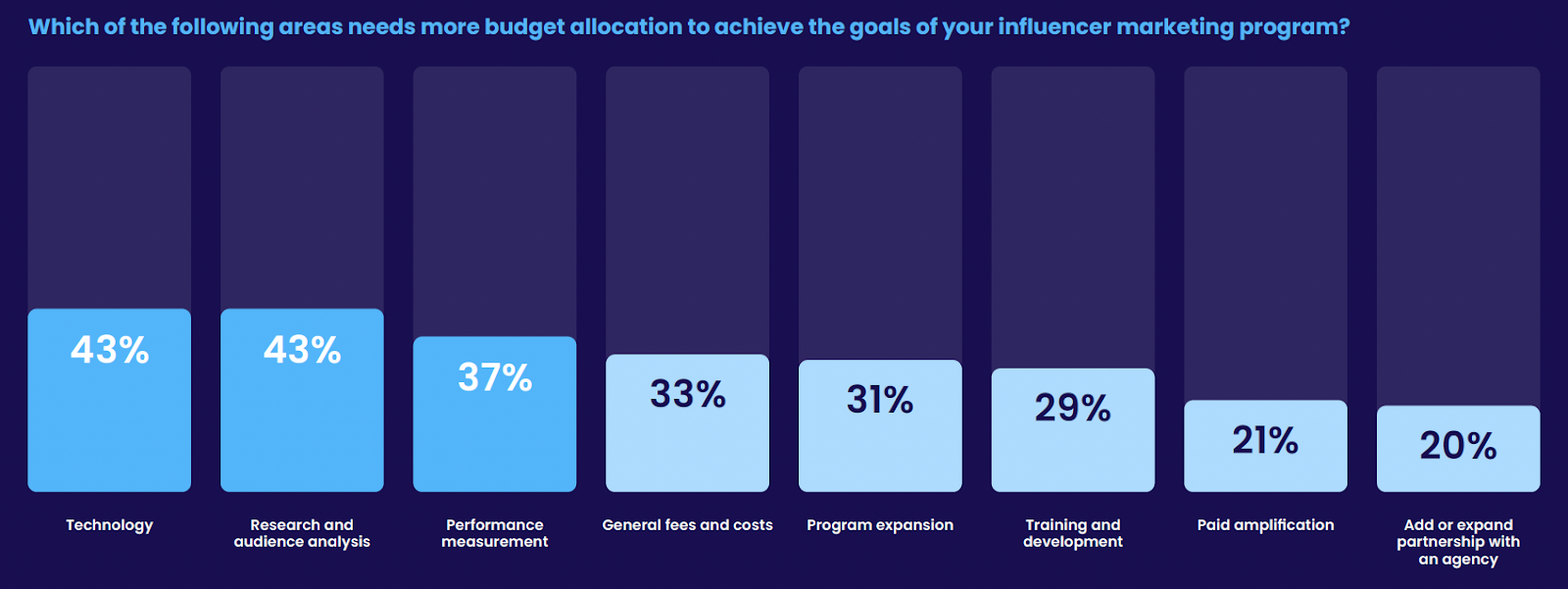Did you know that 61% of B2B leaders believe influencer content deserves a bigger slice of their marketing budget? According to LinkedIn, companies are doubling down on influencer strategies, recognizing them as key drivers of trust and engagement in an increasingly competitive market.
That sentiment is reflected in our own findings. The 2025 B2B Influencer Marketing Report (IMR) from TopRank Marketing reveals that over half of B2B marketing teams with dedicated influencer budgets plan to increase their spending in the next year. What’s driving this momentum? Budgets tend to follow maturity, meaning the more advanced your influencer program, the bigger the investment.
In this post, we’ll unpack the 2025 data, explore where marketers are seeing the biggest opportunities (and challenges) for influencer funding, and share practical tips to help you secure the budget you need to take your program to the next level. Let’s dive into the numbers and strategies shaping influencer marketing in the year ahead.
Budget growth insights from the 2025 IMR
It’s no secret that influencer marketing has matured from a “nice to have” to a strategic cornerstone of B2B marketing plans. But what’s driving that shift? Budget growth is a major indicator. According to our findings, most B2B marketing teams not only have dollars specifically allocated for influencer marketing — they’re actively increasing those budgets.
Here’s the breakdown: 53% of surveyed teams report their influencer marketing budgets are growing. That’s a clear signal that brands are recognizing the value of influencer content.
Maturity and budget: Why experience matters
The more advanced the program, the greater the budget optimism. Among companies with the most mature influencer strategies, 72% expect their budgets to grow in the next year.

When it comes to influencer marketing, experience is key to opening up the budget floodgates. The 2025 IMR reveals a clear link between a program’s maturity and its financial backing: the further along a company is in its influencer journey, the more likely it is to secure growing budgets.
Here’s how the data breaks down by phase:
- Exploratory phase: Even in its infancy, influencer marketing shows potential, with 26% of teams in this phase reporting budget growth. This is often driven by initial wins that justify continued investment.
- Developing phase: As teams start to refine their strategies, they gain buy-in from leadership. Nearly half (46%) in this phase report budget increases, reflecting confidence in early results.
- Established phase: For programs that are delivering consistent results, the momentum picks up. Fifty-four percent of established programs see growing budgets as they prove their ROI and scalability.
- Advanced strategy phase: Here’s where the magic happens. Among the most sophisticated programs, 72% report expanding budgets, making it clear that maturity translates directly into financial support.
The takeaway? Maturity matters. As programs move from exploratory to advanced stages, they gain the metrics, confidence, and alignment needed to secure more resources. For marketers just starting out, this is a reminder to build strategically, demonstrate results early, and aim for long-term program development. Those willing to invest in growth now will reap the rewards of larger budgets and more impactful campaigns down the line.
Key areas of influencer marketing needing more budget
The 2025 IMR reveals where B2B marketers see the biggest opportunities (and challenges) for allocating additional dollars. Unsurprisingly, the top priorities relate to tools and insights that help optimize and scale campaigns. As you plan for 2025, these insights are your roadmap to smarter spending.

Technology (43%)
Managing an influencer program is no small feat, and marketers are calling for better tools to make it happen. From influencer identification software to campaign management platforms and CRM integration, these technologies streamline operations and free up teams to focus on strategy.
Research and audience analysis (43%)
Understanding your audience is foundational to any successful campaign, and influencer marketing is no exception. Marketers are prioritizing budget allocation for deeper research and analytics to identify key demographics, evaluate influencer-audience alignment, and optimize messaging. As programs mature, these insights are critical for scaling efforts effectively and targeting with precision.
Performance measurement (37%)
Accurately measuring the success of an influencer program is critical, yet it remains a challenge for many marketers. Teams are prioritizing tools and processes that provide clear, actionable data on campaign performance. From tracking key metrics like engagement and conversions to evaluating ROI, robust performance measurement helps demonstrate value to stakeholders and informs smarter decision-making for future campaigns.
Other areas of need
Beyond tech and analytics, B2B marketers are also identifying other critical gaps:
Influencer fees and content creation (33%): High-quality influencer partnerships and content come with costs.
Program expansion (31%): Scaling programs across regions or channels requires additional resources.
Training and development (29%): Ensuring internal teams and influencers are equipped for success is a key investment.
Paid amplification (21%): As organic reach becomes harder to achieve, boosting influencer content ensures it gets in front of the right audience.

The C-suite’s confidence in influencer marketing
When it comes to securing more budget for influencer marketing, support from top brass is a game-changer. Segmented data from the 2025 IMR highlights an important trend: 76% of C-suite respondents report growing budgets for their influencer programs, signaling strong executive confidence in this channel’s ability to drive results.
Why are leadership teams putting more dollars behind influencers? When leaders see influencer strategies deliver on big-picture priorities like lead generation, brand trust, and customer engagement, they’re more likely to continue investing in them.
How to talk to the C-suite about influencer marketing
Looking to get leadership onboard with expanding your influencer program? These tips can help you make that case.
Demonstrate ROI early and often. Leaders prioritize investments that show measurable results. If you’re seeking more budget, ensure your reports connect influencer marketing outcomes to revenue impact, pipeline growth, or other key business metrics.
Speak their language. Frame influencer marketing as a strategic lever for achieving C-suite priorities. Highlight how it supports broader organizational initiatives like thought leadership or market expansion.
Explain the competitive advantage. Share data (like that found in the IMR) with leadership that demonstrates influencer marketing’s emergence as a critical focus across industries. This will help you demonstrate how investing in influencer programs offers an edge over competitors who are falling behind on influencer marketing.
When executives see the value in a tactic, they champion it. For marketers, this is an opportunity to move your program forward leaps and bounds in capability, rapidly unlocking the resources to grow your program.
“Influencer marketing as a discipline has been maturing over the past decade and is now an integral component of the marketing flywheel. The ability to reach new and varied audiences through partnerships with trusted creators and influencers is of keen interest to modern marketing leaders.” – Angela Lipscomb, Influencer Relations Manager, SAS
Unlocking influencer marketing potential in 2025
As we step into 2025, one thing is clear: influencer marketing is no longer optional for B2B brands. With growing budgets, increasing executive buy-in, and a strong correlation between program maturity and financial investment, this channel is firmly cementing its place as a strategic driver of growth.
Whether you’re in the exploratory phase or running a fully established influencer program, use the 2025 IMR as your roadmap to refine your program. Here are some tips to get you started:
- Assess program maturity. Determine where your program sits on the exploratory-to-advanced spectrum and identify the steps needed to advance.
- Pinpoint budget gaps. Use the data from the IMR to compare your program’s spend to industry trends and ensure you’re prioritizing high-impact areas like technology and research.
- Build a business case. Present leadership with a data-driven plan that ties influencer marketing investments to business outcomes.
Download the 2025 Influencer Marketing Report to gain a wealth of actionable insights, and contact us to learn how our influencer marketing expertise can help you stay ahead of the competition.



